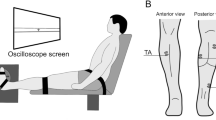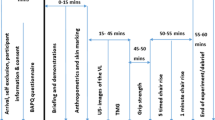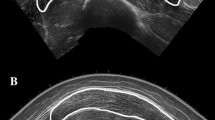Summary
Thirty women, divided among three different age groups, i.e. 30 years (range 26–35;n = 10), 50 years (range 46–55;n = 10) and 70 years (range 66–75;n = 10) volunteered as subjects for examination of the characteristics of the muscle cross-sectional area (CSA), maximal voluntary isometric force, isometric force-time and relaxation-time of their leg extensor muscles. The CSA of the quadriceps femoris muscle in the youngest age group was slightly larger (NS) than in the middle-aged group and much larger (P<0.41) than in the oldest age group whose CSA was markedly smaller (P<0.01) than the middle-aged group. Maximal force in the youngest group was slightly greater (NS) than in the middle-aged group and much greater (P<0.01) than in the oldest group whose values were markedly smaller (P<0.05) than the middle-aged group. The individual values in CSA correlated with maximal force both in the total subject sample (r=0.82;P<0.001) and in the three age groups separately (r=0.72;P<0.01;r=0.86;P<0.01 andr=0.67;P<0.05, respectively). When the force values were related to the CSA of the muscle, the mean values of 45.4N·cm−2, SD 5.6, 47.6 N·cm−2, SD 5.0 and 46.8 N· cm−2, SD 7.0 for the three groups did not differ significantly from each other. The isometric force-time curves differed among the groups, so that the times to produce the same absolute as well as relative force levels were shorter in the 30-year age group (P<0.05) than in the 70-year age group. The times of relaxation did not differ significantly among the groups. The present results suggested that the decline in maximal force in females with age could well be related to the decline in the cross-sectional area of the muscle. However, the time taken in the production of explosive force may worsen even more than maximal strength especially at older ages. This indicated that atrophying effects of aging may be greater on fast than on slow twitch muscle fibres and/or that the rate of neural activation of the muscles could also be influenced by aging.
Similar content being viewed by others
References
Aniansson A, Grimby G, Hedberg M, Krotkiewski M (1981) Muscle morphology, enzyme activity and muscle strength in elderly men and women. Clin Physiol 1:73–86
Asmussen E (1980) Aging and exercise. In: Horvath S, Yousef M (eds) Environmental physiology: aging, heat and altitude. Elsevier, Amsterdam, pp 419–428
Clarkson P, Kroll W, Melchiond A (1981) Age, isometric strength, rate of tension development and fiber type composition. J Gerontol 36:648–653
Durnin J, Womersley Y (1967) Body fat assessed from total body density and its estimation from skinfold thickness: measurements on 481 men and women aged from 16 to 72 years. Br J Nutr 32:77–97
Essen-Gustavsson B, Borges O (1986) Histochemical and metabolic characteristics of human skeletal muscle in relation to age. Acta Physiol Scand 126:107–114
Gandee R, Hollering B, Kikukawa N, Rogers S, Narraway A, Newman I, Haude R (1989) The influence of age upon isokinetic leg strength of adult males. In: Harris R (ed) Physical activity, aging and sports, vol. 1. Albany, New York, pp 369–373
Grimby G (1988) Physical activity and effects of muscle training in the elderly. Ann Clin Res 20:62–66
Häkkinen K (1989a) Neuromuscular and hormonal adaptations during strength and power training. A review. J Sports Med 29:9–26
Häkkinen K (1989b) Muscle cross-sectional area, force production and relaxation characteristics in males, females, male and female strength athletes. In: Högfors C (ed) Proceedings of the 3rd Biomechanics Seminar, Centre for Biomechanics, Chalmers University of Technology and Göteborg University, Göteborg, pp 144–161
Häkkinen K, Viitasalo JT, Komi PV (1980) Die Wirkung unterschiedlich kombinierter konzentrischer und exzentrischer Muskelarbeit auf Kraft-Zeit-Merkmale der Beinstreck-Muskulatur. Leistungssport 10:374–381
Heikkinen E, Arajärvi RL, Era P, Jylhä M, Kinnunen V, Leskinen AL, Leskinen E, Mässeli E, Pohjolainen P, Rahkila P, Suominen H, Turpeinen P, Väisänen M, Osterback L (1984) Functional capacity of men born in 1906–1910, 1926–30 and 1946–1950. A basic report. Scand J Soc Med [Suppl] 33:1–93
Komi PV (1973) A new electromechanical ergometer. In: Hauser G, Mellercowicz H (eds) Third Internationales Seminar für Ergometrie, Ergon, Berlin, pp 173–176
Komi PV (1986) Training of muscle strength and power: interaction of neuromotoric, hypertrophic, and mechanical factors. Int J Sports Med [Suppl] 7:10–15
Kovanen V (1989) Effects of aging and physical training in rat skeletal muscle. Acta Physiol Scand [Suppl] 135:577
Larsson L (1978) Morphological and functional characteristics of the aging skeletal muscle in man. A cross-sectional study. Acta Physiol Scand [Suppl 457]:1–36
Larsson L (1982) Physical training effects on muscle morphology in sedentary males at different ages. Med Sci Sports Exerc 14:203–206
Larsson L, Sjödin B, Karlsson J (1978) Histochemical and biochemical changes in human skeletal muscle with age in sedentary males age 22–65 years. Acta Physiol Scand 103:31–39
Lexell J, Henriksson-Larsén K, Winblad B, Sjöström M (1983) Distribution of different fiber types in human skeletal muscles. 3. Effects of aging studied in whole muscle cross section. Muscle Nerve 6:588–595
Maughan RJ, Watson JS, Weir J (1983) Relationship between muscle strength and muscle cross-sectional area in male sprinters and endurance runners. Eur J Appl Physiol 50:309–318
Murray M, Gardner G, Mollinger L (1980) Strength of isometric and isokinetic contractions: knee muscles of men aged 20–86. Phys Ther 60:412–419
Ryushi T, Häkkinen K, Kauhanen H, Komi PV (1988) Muscle fiber characteristics, muscle cross-sectional area and force production in strength athletes, physically active males and females. Scand J Sports Sci 10:7–15
Suominen H, Rahkila P, Era P, Jaakkola L, Heikkinen E (1989) Functional capacity in middle-aged male endurance and power athletes. In: Harris R (ed) Physical activity, aging and sports, vol 1. Albany, New York, pp 213–218
Viitasalo JT, Komi PV (1978) Force-time characteristics and fibre composition in human leg extensor muscles. Eur J Appl Physiol 40:7–15
Viitasalo JT, Saukkonen S, Komi PV (1980) Reproducibility of measurements of selected neuromuscular performance variables in man. Electromyogr Clin Neurophysiol 20:487–501
Viitasalo JT, Era P, Leskinen AL, Heikkinen E (1985) Muscular strength profiles and anthropometry in random samples of men aged 31 to 35, 51 to 55 and 71 to 75 years. Ergonomics 28:1503–1574
Young A, Stokes M, Crowe M (1984) Size and strength of quadriceps muscles of old and young women. Eur J Clin Invest 14:282–287
Author information
Authors and Affiliations
Rights and permissions
About this article
Cite this article
Häkkinen, K., Häkkinen, A. Muscle cross-sectional area, force production and relaxation characteristics in women at different ages. Europ. J. Appl. Physiol. 62, 410–414 (1991). https://doi.org/10.1007/BF00626612
Accepted:
Issue Date:
DOI: https://doi.org/10.1007/BF00626612




